




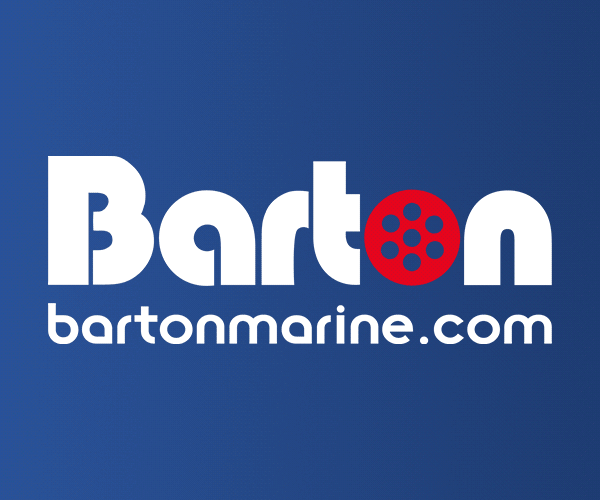


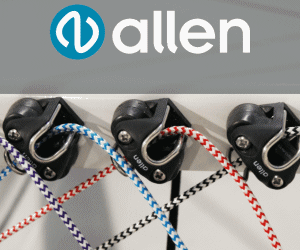


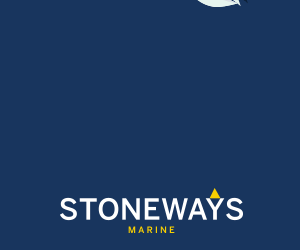

| Laser 28 - Excellent example of this great design Hamble le rice |
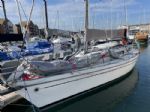 |
| Laser 140101 Tynemouth |
 |
| Rossiter Pintail Mortagne sur Gironde, near Bordeaux |
 |
List classes of boat for sale |
Right of way with three or more boats |
Post Reply 
|
Page 12> |
| Author | ||||
JimC 
Really should get out more 

Joined: 17 May 04 Location: United Kingdom Online Status: Offline Posts: 6662 |
 Post Options Post Options
 Quote Quote  Reply Reply
 Topic: Right of way with three or more boats Topic: Right of way with three or more boatsPosted: 15 Jul 10 at 8:50am |
|||
To my way of thinking in that picture C is toast: not keeping clear when there's room to go up. If B and C established an overlap from behind A's only obligation is to give them enough room not to hit the Commitee boat. If they have to luff nearly head to wind to do it well that's tough. B may well escape: it depends on how the overlap with C was established. If B gained an overlap when A and C had room then its different from vv I believe. But yes, if A wants to close the door completely they have to do it early anough that B and C can tack before they reach the committee boat. Edited by JimC |
||||
 |
||||
Brass 
Really should get out more 
Joined: 24 Mar 08 Location: Australia Online Status: Offline Posts: 1151 |
 Post Options Post Options
 Quote Quote  Reply Reply
 Posted: 15 Jul 10 at 2:49am Posted: 15 Jul 10 at 2:49am |
|||
|
Read rule 20 again. B's obligation is to tack (or hail 'You tack') in response to A's hail. If A tacks before B responds, then A probably breaks rule 20. Secondly, B's rule 20 obligation is to give A room to tack and avoid her, not to keep clear. But so be it: A and B have both tacked onto PORT and and are now approaching C on STBD.
Once on PORT, B has no entitlement whatsoever to hail C for room. Rule 20 only gives a boat an entitlement to hail a boat on the same tack. At the second position in your diagram, A and B are purely in Case 11 territory: two boats on Port approaching a boat on starboard. B may elect to duck C, in which case she must give A room to do likewise, or B may give A a rule 20 hail for room to tack away from C, and A must respond. If B uses rule 20 to tack away from C and A tacks, then, A will be entitled to give another rule 20 hail to B (because of the original obstruction), who must then respond, but by then, C will be out of the way and they can both get on with their race.
Well it's a matter of choice for B, but it is not a problem for C, who is the right of way boat, subject only to the rule 16.1 limitation that if she changes course she must give A and B room to keep clear of her.
See above. C certainly had no obligation to tack. It was up to A and B to keep clear of C. Going head to wind and slowing is a perfectly seamanlike way for B to honour her keep clear obligation. What you describe is pretty much exactly how the rules require the situation to play out. As we have discussed, under Case 113, had C been closer in on B's hip, then it would have been different and C would have been obliged to respond, although she could have responded by hailing 'You tack', slowing down, and still been able to put B about again. I suggest you consider the philosophy of rule 20 this way. Rule 20 is a safety rule that requires a boat, in a tactically controlling position to windward of a close hauled boat approaching an obstruction that safety requires her to tack away from, to sacrifice (or at least diminish) her controlling position (lead) in a limited and controlled way, so that the leeward boat can safely avoid the obstructon. Rule 20 allows the windward boat to minimise her detriment, and will penalise the leeward hailing boat if she abuses the rule. |
||||
 |
||||
NickA 
Really should get out more 
Joined: 30 Mar 05 Location: United Kingdom Online Status: Offline Posts: 784 |
 Post Options Post Options
 Quote Quote  Reply Reply
 Posted: 14 Jul 10 at 8:48pm Posted: 14 Jul 10 at 8:48pm |
|||
|
As for my second example (not to scale - the boats came out too big!).
 Taking Brass's advice on treating the matter as two pairs of boats. A (red) has already tacked and B (blue) has tacked in response in order to keep clear - fine. For the next pair, B isn't hailing C (green) to tack and whether or not he should depends, I guess on how much B is really up against an obstruction. Problem is, it's a matter of judgement as to whether B can duck C or has room to tack back to starboard and duck A. How is C to know? (In the event, C called "starboard" and refused to tack; B complained that there was a boat beneath him avoiding the shore, but went head to wind to avoid a collision and stopped, then bore off below C whilst A sailed over the top of him - no-one took a penalty and C got ahead and won). That link probably answers the question .... but it doesn't seem to work for me. |
||||
|
Javelin 558
Contender 2574 |
||||
 |
||||
NickA 
Really should get out more 
Joined: 30 Mar 05 Location: United Kingdom Online Status: Offline Posts: 784 |
 Post Options Post Options
 Quote Quote  Reply Reply
 Posted: 14 Jul 10 at 8:23pm Posted: 14 Jul 10 at 8:23pm |
|||
|
Think Brass may be right on this one (here's a picture).
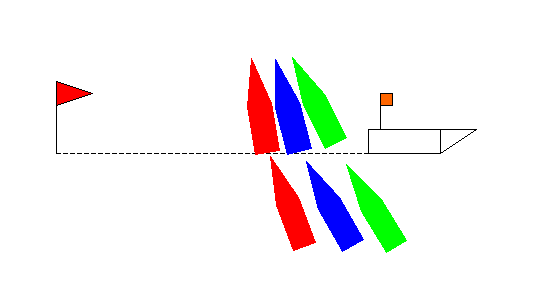 B (Blue) annd C (Green) didn't really have room above A (red) who can sail notoriously high and will luff to his highest point of sail as soon as the gun goes. But all the same, there was room on the start line and A didn't leave room after the gun went off. Seems that if A wanted to shut B & C out, he should have done it before the start. So is Brass correct that A is in the wrong? When this happened to me, boat A sailed off and won the race whilst B & C did turns!!!!!! Edited by NickA |
||||
|
Javelin 558
Contender 2574 |
||||
 |
||||
asterix 
Really should get out more 
Joined: 01 Aug 09 Location: United Kingdom Online Status: Offline Posts: 621 |
 Post Options Post Options
 Quote Quote  Reply Reply
 Posted: 14 Jul 10 at 8:41am Posted: 14 Jul 10 at 8:41am |
|||
the two descriptions of case 113 are identical - arn't they? |
||||
 |
||||
Brass 
Really should get out more 
Joined: 24 Mar 08 Location: Australia Online Status: Offline Posts: 1151 |
 Post Options Post Options
 Quote Quote  Reply Reply
 Posted: 14 Jul 10 at 12:20am Posted: 14 Jul 10 at 12:20am |
|||
For goodness sake, guys, use the up to date Case Book that ISAF provides: http://www.sailing.org/tools/documents/CaseBook20092012with2 010changes-[8229].pdf |
||||
 |
||||
Brass 
Really should get out more 
Joined: 24 Mar 08 Location: Australia Online Status: Offline Posts: 1151 |
 Post Options Post Options
 Quote Quote  Reply Reply
 Posted: 14 Jul 10 at 12:17am Posted: 14 Jul 10 at 12:17am |
|||
|
If A hails and tacks simultaneously, she has not given B time to respond and If C is so close to A and B that C will have to respond before A is able to tack, then C is a 'hailed boat' and must respond in accordance with rule 20 (Case 113). If, on the other hand, C is a little more separated from A and B, so that it is NOT necessary for C to respond before A is able to tack, then C is NOT a 'hailed boat' and owes no obligation under rule 20. Under rule 20, B is required to tack or give A room to tack and avoid her: in neither case is she required to keep clear of A, thus, A, tacking, is NOT an obstruction to B, and B has no entitlement to hail C under rule 20, unless safety requires B herself to make a substantial course change to avoid the shore. Generally, a boat having responded to a rule 20 hail by hailing 'You tack', and giving room to tack, may then stand on and force the hailing boat to tack again (Case 101). Edited by Brass |
||||
 |
||||
JimC 
Really should get out more 

Joined: 17 May 04 Location: United Kingdom Online Status: Offline Posts: 6662 |
 Post Options Post Options
 Quote Quote  Reply Reply
 Posted: 14 Jul 10 at 12:08am Posted: 14 Jul 10 at 12:08am |
|||
|
Well lets go through the first one... I'm no expert at this but...
Part A, Rule 11 applies, windward/leeward so B must keep clear of A and C keep clear of B. I don't see why Matt thinks A can't luff, assuming B and C both established overlaps from leeward. Rule 14 no collisions applies to all, but if there was no damage or injury A cannot be penalised being ROW boat. Rule 15 doesn't apply to A: A was always ROW boat. It might apply to B, we don't know. Rule 16.1 applies A on B, B on C Rule 17 doesn't apply to A, might apply to B, we don't know. None of Section C applies because its a start. So A is entitled to luff B (and C), subject to room C did not touch the committee boat: did they respond to B adequately? The CB witnesses will be very important for this one... |
||||
 |
||||
Brass 
Really should get out more 
Joined: 24 Mar 08 Location: Australia Online Status: Offline Posts: 1151 |
 Post Options Post Options
 Quote Quote  Reply Reply
 Posted: 13 Jul 10 at 11:57pm Posted: 13 Jul 10 at 11:57pm |
|||
|
You can generally get through complicated situations by applying the rules 'pairwise' between boats. Where B cannot respond because of the presence of C and C cannot respond becaues of the RC Boat, then A, changing course, has not given B room to keep clear and breaks rule 16.1. A, having nothing to leeward to prevent her from bearing away to avoid contact also breaks rule 14, but might be protected from penalty if there is no injury or damage under rule 14(b). B does not keep clear of A. B breaks rule 11. B, changing course has not given C room to keep clear and breaks rule 16.1. B is compelled to break rules 11 and 16.1 because of A breaking rule 16.1. B should be exonerated under rule 64.1(c). Because she is compelled by A, it is not reasonably possible for B to avoid contact with A or C and B does not break rule 14. C does not keep clear of B. C breaks rule 11. C is compelled ot break rule 11 because of B breaking rule 16.1. C should be exonerated under rule 64.1(c). Because she is compelled by B, it is not reasonably possible for C to avoid contact with B and C does not break rule 14. The scenario has B and C becoming overlapped on A from CASTN to windward of A. Rule 17 and proper course do not apply.
|
||||
 |
||||
Garry 
Really should get out more 
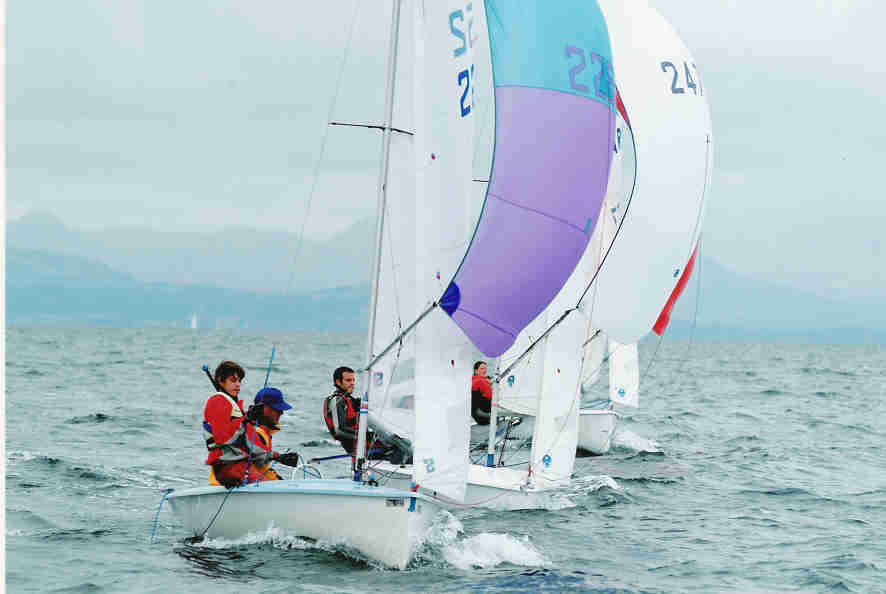
Joined: 18 Apr 04 Location: United Kingdom Online Status: Offline Posts: 536 |
 Post Options Post Options
 Quote Quote  Reply Reply
 Posted: 13 Jul 10 at 9:14pm Posted: 13 Jul 10 at 9:14pm |
|||
|
I tend to agree with Matt although it depends on when and
how the overlaps were established. However, the words luffs sharply would also imply that B wasn't given time to respond as they would have to wait for C to respond and A needs to allow for that when altering course. Since there was contact I'm not sure A would be successful in a protest since there would appear to be no reason why A couldn't have avoided contact rule 14 I think, since it's A's course change that caused the contact. My guess is A left it too late to close the door on B and C and would have been better hiking hard to heel to windward and giving B dirty air or if handicap racing and B was a lot faster bearing away to open a gap so they could tack away for clear air. On the limited facts presented I'd be very tempted to disqualify A Edited by Garry |
||||
|
Garry
Lark 2252, Contender 298 www.cuckoos.eclipse.co.uk |
||||
 |
||||
Post Reply 
|
Page 12> |
| Forum Jump | Forum Permissions  You cannot post new topics in this forum You cannot reply to topics in this forum You cannot delete your posts in this forum You cannot edit your posts in this forum You cannot create polls in this forum You cannot vote in polls in this forum |
Copyright ©2001-2010 Web Wiz
Change your personal settings, or read our privacy policy












 Printable Version
Printable Version Delicious
Delicious Digg
Digg Facebook
Facebook Furl
Furl Google
Google MySpace
MySpace Newsvine
Newsvine reddit
reddit StumbleUpon
StumbleUpon Twitter
Twitter Windows Live
Windows Live Yahoo Bookmarks
Yahoo Bookmarks Topic Options
Topic Options